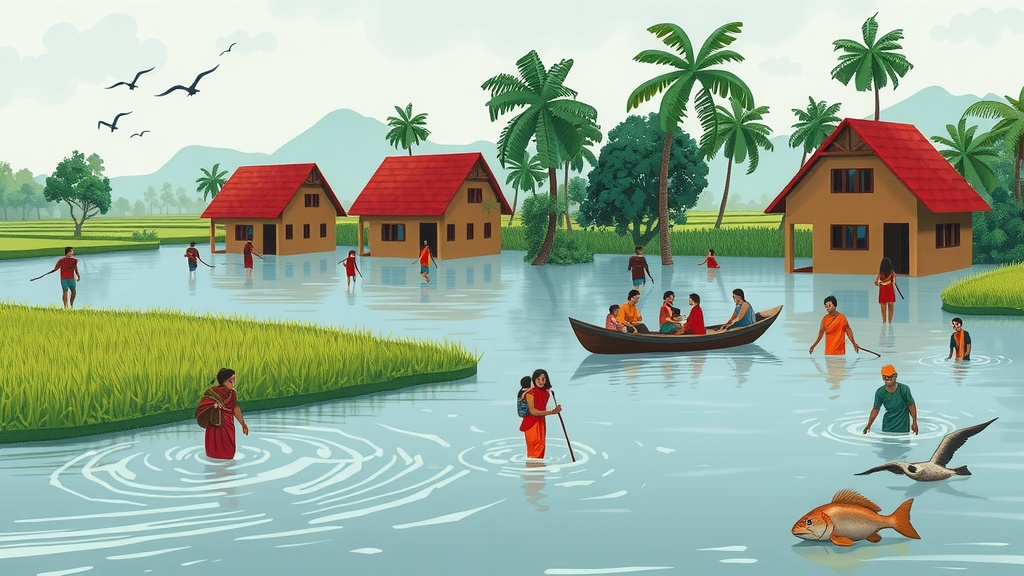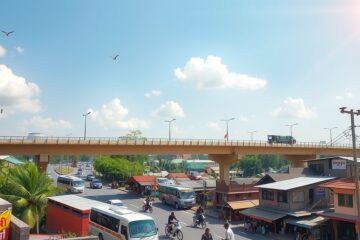In Bangladesh, the monsoon season isn’t just about rain; it’s about the looming threat of floods. Like a yearly guest, sometimes welcome and sometimes not, floods have shaped our land and our lives. From the rice fields of our villages to the bustling streets of Dhaka, no place is untouched by their potential impact. But what exactly makes Bangladesh so prone to floods? And how can we, as a nation, learn to live with this watery reality? Let’s dive into this topic, exploring the causes, effects, and possible solutions, all while keeping it relatable and easy to understand.
Understanding Floods in Bangladesh
Floods in Bangladesh are a recurring phenomenon, almost as predictable as the seasons themselves. But why is our country so susceptible to these inundations? The answer lies in a combination of geographical factors, climate patterns, and human activities. Imagine Bangladesh as a giant floodplain, where mighty rivers like the Padma (Ganges), Meghna, and Jamuna (Brahmaputra) converge and eventually drain into the Bay of Bengal.
Think of it like this: if you pour too much water into a sink that drains slowly, it’s bound to overflow. That’s essentially what happens during the monsoon season when heavy rainfall combines with the melting snow from the Himalayas, swelling our rivers beyond their capacity.
Geographical Factors
Bangladesh’s location at the delta of three major rivers makes it incredibly fertile but also highly vulnerable to floods. The country is predominantly flat, with much of its land lying only a few meters above sea level. This low elevation means that even a small rise in water levels can inundate vast areas.
- Low Elevation: Like a shallow dish, Bangladesh has limited capacity to contain excess water.
- River Confluence: The combined flow of the Padma, Meghna, and Jamuna rivers creates immense water volume.
- Deltaic Plain: The flat, deltaic terrain allows floodwaters to spread quickly and widely.
Climatic Factors
The monsoon season, which lasts from June to October, brings torrential rainfall to Bangladesh. This rainfall, combined with the runoff from the Himalayas, overwhelms the river systems.
- Monsoon Rainfall: Intense and prolonged rainfall during the monsoon season.
- Himalayan Snowmelt: Melting snow from the Himalayas adds to the river flow.
- Tropical Cyclones: Cyclones originating in the Bay of Bengal can bring storm surges and heavy rainfall, exacerbating floods.
Human Factors
While natural factors play a significant role, human activities also contribute to the severity of floods in Bangladesh.
- Deforestation: Reduced forest cover in the upstream areas leads to increased runoff and soil erosion.
- Unplanned Urbanization: Construction in low-lying areas and inadequate drainage systems worsen urban flooding.
- River Encroachment: Illegal construction along riverbanks reduces the river’s capacity to carry water.
The Impact of Floods on Bangladesh
Floods can have devastating consequences for Bangladesh, affecting various aspects of life, from agriculture to infrastructure to public health.
Economic Impact
Agriculture, the backbone of the Bangladeshi economy, is severely affected by floods. Crops are destroyed, livestock is lost, and agricultural land becomes infertile due to siltation.
- Crop Damage: Standing crops are submerged, leading to significant yield losses.
- Livestock Loss: Animals are drowned or swept away by floodwaters.
- Infrastructure Damage: Roads, bridges, and irrigation systems are damaged, disrupting transportation and agricultural activities.
Imagine a farmer who has invested all his savings into cultivating his land, only to see his crops washed away by a sudden flood. This is a common scenario in Bangladesh, and it can push families into poverty.
Social Impact
Floods displace millions of people every year, forcing them to seek shelter in temporary relief camps. These camps often lack basic amenities, leading to unsanitary conditions and the spread of diseases.
- Displacement: People are forced to leave their homes and seek shelter elsewhere.
- Health Crisis: Waterborne diseases like cholera, diarrhea, and typhoid spread rapidly.
- Food Scarcity: Disruption of supply chains leads to food shortages and price hikes.
Think of the chaos and distress of families being uprooted from their homes, losing their belongings, and struggling to find food and shelter. It’s a humanitarian crisis that unfolds every year in Bangladesh.
Environmental Impact
Floods can cause significant environmental damage, including soil erosion, water pollution, and loss of biodiversity.
- Soil Erosion: Floodwaters carry away topsoil, reducing soil fertility.
- Water Pollution: Contamination of water sources with sewage and industrial waste.
- Habitat Destruction: Loss of habitat for aquatic and terrestrial species.
Imagine the impact on our rivers and wetlands, which are already under stress from pollution and overexploitation. Floods exacerbate these problems, threatening the delicate balance of our ecosystems.
Flood Management Strategies in Bangladesh
While we cannot completely eliminate floods, we can certainly mitigate their impact through effective flood management strategies. These strategies involve a combination of structural measures, non-structural measures, and community participation.
Structural Measures
Structural measures involve the construction of physical infrastructure to control and divert floodwaters.
- Embankments: Building embankments along riverbanks to prevent overflowing.
- Dams and Reservoirs: Constructing dams and reservoirs to store excess water.
- Drainage Systems: Improving drainage systems in urban areas to quickly remove floodwaters.
Think of these measures as building a strong defense against the floodwaters. Embankments act as barriers, dams regulate the flow of water, and drainage systems ensure that water doesn’t accumulate in urban areas.
Non-Structural Measures
Non-structural measures involve policies, regulations, and awareness programs to reduce vulnerability to floods.
- Flood Forecasting and Warning Systems: Providing timely warnings to people at risk of flooding.
- Land Use Planning: Restricting construction in flood-prone areas.
- Disaster Preparedness Programs: Educating communities on how to prepare for and respond to floods.
These measures are like equipping people with the knowledge and tools they need to protect themselves. Early warnings allow people to evacuate, land-use planning prevents risky construction, and preparedness programs empower communities to take action.
Community Participation
Engaging local communities in flood management is crucial for the success of any strategy. Local knowledge and participation can help identify vulnerable areas, implement effective measures, and ensure sustainability.
- Community-Based Disaster Management: Training local volunteers to respond to floods.
- Participatory Planning: Involving communities in the planning and implementation of flood management projects.
- Awareness Campaigns: Educating communities about flood risks and prevention measures.
Imagine empowering communities to become active participants in protecting themselves. Local knowledge can complement scientific expertise, leading to more effective and sustainable solutions.
Paragraph on Flood in Bangladesh for Class 6-12, SSC, HSC
Now, let’s tailor our understanding of floods in Bangladesh to different academic levels. Here are sample paragraphs suitable for Class 6-12, SSC, and HSC students, with varying word counts.
Paragraph on Flood in Bangladesh for Class 6 (150 words)
Floods are a common problem in Bangladesh. Our country is a delta, and many rivers flow through it. During the rainy season, these rivers get too full, and the water spills over the banks, causing floods. Floods can damage homes, schools, and farms. People lose their belongings and have to move to safer places. Sometimes, floods can also spread diseases. The government and other organizations help people during floods by providing food, shelter, and medical care. We can also help by planting more trees, keeping our rivers clean, and being prepared for floods.
Paragraph on Flood in Bangladesh for Class 8 (200 words)
Bangladesh is a land of rivers, and floods are a regular occurrence, especially during the monsoon season. Heavy rainfall and overflowing rivers cause widespread inundation, affecting millions of people. Floods damage crops, destroy homes, and disrupt transportation. They also lead to waterborne diseases and food shortages. The government and NGOs work to provide relief to flood-affected people by distributing food, water, and medicine. To reduce the impact of floods, it is important to build strong embankments, improve drainage systems, and raise awareness among communities about flood preparedness. We should also focus on sustainable development practices to minimize the human contribution to flooding.
Paragraph on Flood in Bangladesh for Class 10 (250 words)
Floods in Bangladesh are a recurring natural disaster that poses a significant threat to the country’s economy and environment. The geographical location of Bangladesh, at the confluence of major rivers like the Padma, Meghna, and Jamuna, makes it highly vulnerable to flooding during the monsoon season. Heavy rainfall, coupled with the melting of Himalayan snow, causes these rivers to overflow, inundating vast areas of land. The consequences of floods are far-reaching, including damage to crops, infrastructure, and homes, as well as displacement of people and outbreaks of waterborne diseases. To mitigate the impact of floods, Bangladesh needs to invest in comprehensive flood management strategies, including the construction of embankments and drainage systems, improved flood forecasting and warning systems, and community-based disaster preparedness programs. Sustainable development practices, such as afforestation and responsible land use, are also essential to reduce the risk of flooding.
Paragraph on Flood in Bangladesh for SSC (300 words)
Bangladesh, being a low-lying deltaic country, is extremely susceptible to floods, a recurring phenomenon that brings widespread devastation. The convergence of the Padma, Meghna, and Jamuna rivers, combined with heavy monsoon rains and snowmelt from the Himalayas, results in frequent and severe floods. These floods have profound impacts on the socio-economic fabric of the nation. Agriculture, the mainstay of the Bangladeshi economy, suffers immensely as crops are submerged and livestock is lost. Infrastructure, including roads, bridges, and houses, is severely damaged, disrupting communication and daily life. Millions of people are displaced, often forced to live in temporary shelters with inadequate sanitation and healthcare facilities, leading to outbreaks of waterborne diseases.
Effective flood management is crucial for Bangladesh’s sustainable development. Structural measures, such as the construction of embankments, dams, and drainage systems, play a vital role in controlling floodwaters. However, non-structural measures, including improved flood forecasting and warning systems, land-use planning, and community-based disaster preparedness programs, are equally important. Furthermore, addressing the root causes of flooding, such as deforestation and climate change, is essential for long-term resilience. Community participation in flood management initiatives is also vital, as local knowledge and experience can contribute to more effective and sustainable solutions. By adopting a holistic and integrated approach to flood management, Bangladesh can reduce its vulnerability to this recurring disaster and build a more resilient future for its people.
Paragraph on Flood in Bangladesh for HSC (350 words)
The geographical context of Bangladesh, situated in the low-lying delta of the Ganges-Brahmaputra-Meghna river system, renders it exceptionally vulnerable to recurrent and devastating floods. The confluence of these major rivers, combined with intense monsoon rainfall and snowmelt from the Himalayas, leads to frequent inundations during the monsoon season. These floods have far-reaching consequences, impacting the nation’s economy, society, and environment.
Economically, floods cripple the agricultural sector, which is the backbone of Bangladesh’s economy. Widespread crop damage, livestock losses, and destruction of agricultural infrastructure result in significant economic setbacks. Socially, floods displace millions of people, forcing them into temporary shelters with limited access to basic necessities, thus exacerbating health risks and social inequalities. Environmentally, floods cause soil erosion, water pollution, and habitat destruction, further degrading the country’s natural resources.
Addressing the challenge of floods requires a comprehensive and multi-faceted approach. Structural measures, such as the construction of embankments, dams, and improved drainage systems, are essential for controlling floodwaters. However, non-structural measures, including enhanced flood forecasting and warning systems, land-use planning, and community-based disaster preparedness programs, are equally critical for minimizing the impact of floods. Furthermore, addressing the underlying causes of flooding, such as deforestation, climate change, and unsustainable development practices, is crucial for long-term resilience.
Effective flood management also necessitates community participation, empowering local communities to take ownership of flood preparedness and response efforts. By integrating local knowledge and experience, flood management initiatives can be more effective and sustainable. Moreover, regional cooperation among countries sharing the Ganges-Brahmaputra-Meghna river basin is essential for addressing transboundary water management issues and mitigating the risk of floods. In conclusion, by adopting a holistic and integrated approach to flood management, Bangladesh can reduce its vulnerability to floods and build a more resilient and sustainable future for its people.
FAQs about Floods in Bangladesh
Let’s address some common questions people have about floods in Bangladesh.
Why are floods so common in Bangladesh?
Bangladesh is located in a low-lying delta region where three major rivers converge. Heavy monsoon rainfall and snowmelt from the Himalayas cause these rivers to overflow, leading to widespread flooding.
What are the main causes of floods in Bangladesh?
The main causes include heavy monsoon rainfall, snowmelt from the Himalayas, the country’s low elevation, and the convergence of major rivers. Human factors like deforestation and unplanned urbanization also contribute.
What are the effects of floods on people’s lives in Bangladesh?
Floods can lead to displacement, loss of homes and belongings, food shortages, waterborne diseases, and economic hardship.
How does climate change affect flooding in Bangladesh?
Climate change is expected to increase the frequency and intensity of floods in Bangladesh due to rising sea levels, increased rainfall, and more frequent extreme weather events.
What can be done to reduce the impact of floods in Bangladesh?
Effective flood management strategies include building embankments, improving drainage systems, implementing flood forecasting and warning systems, promoting sustainable land use, and engaging communities in disaster preparedness.
What is the government doing to help flood victims in Bangladesh?
The government provides relief and assistance to flood victims, including food, shelter, medical care, and financial support. It also invests in flood management infrastructure and programs.
How can individuals prepare for floods in Bangladesh?
Individuals can prepare by staying informed about flood warnings, evacuating to safer locations when necessary, storing food and water, and participating in community-based disaster preparedness programs.
The Role of Technology in Flood Management
In recent years, technology has emerged as a powerful tool in flood management, offering innovative solutions for monitoring, forecasting, and responding to floods.
Remote Sensing and GIS
Remote sensing technologies, such as satellites and drones, can provide real-time data on river water levels, rainfall patterns, and flood extent. Geographic Information Systems (GIS) can be used to analyze this data and create flood risk maps, helping to identify vulnerable areas and plan mitigation measures.
Imagine using satellites to monitor the swelling of rivers and predict where floods are likely to occur. This information can be used to issue timely warnings and evacuate people from harm’s way.
Early Warning Systems
Advanced early warning systems can provide timely and accurate information to people at risk of flooding. These systems use weather forecasts, hydrological models, and communication technologies to disseminate warnings through various channels, such as mobile phones, radio, and television.
Think of receiving a text message on your phone warning you about an impending flood. This can give you valuable time to prepare and evacuate, potentially saving lives and property.
Mobile Technology
Mobile technology can play a crucial role in disaster response and relief efforts. Mobile apps can be used to report flood-related incidents, coordinate rescue operations, and provide information to affected communities.
Imagine using a mobile app to report a flooded road or request assistance from rescue teams. This can help streamline relief efforts and ensure that help reaches those who need it most.
The Future of Flood Management in Bangladesh
As climate change continues to exacerbate the risk of flooding, Bangladesh needs to adopt a more proactive and adaptive approach to flood management. This involves investing in resilient infrastructure, promoting sustainable development practices, and empowering communities to cope with floods.
Climate-Resilient Infrastructure
Building infrastructure that can withstand the impacts of climate change is essential for reducing vulnerability to floods. This includes constructing stronger embankments, improving drainage systems, and raising the elevation of roads and buildings.
Think of building houses on stilts to protect them from floodwaters or designing roads that can withstand inundation. This can help minimize damage and disruption during floods.
Sustainable Development Practices
Promoting sustainable development practices, such as afforestation, responsible land use, and water conservation, can help reduce the risk of flooding and mitigate the impacts of climate change.
Imagine planting trees along riverbanks to prevent erosion or adopting water-efficient irrigation techniques to reduce water demand. This can help create a more sustainable and resilient environment.
Community Empowerment
Empowering communities to take ownership of flood preparedness and response efforts is crucial for building resilience. This involves providing training, resources, and support to local communities, enabling them to protect themselves and their livelihoods.
Think of training local volunteers to respond to floods or providing communities with the tools and equipment they need to evacuate and provide first aid. This can help build a more resilient and self-reliant society.
Conclusion: Living with Water
Floods in Bangladesh are a complex and multifaceted challenge that requires a comprehensive and integrated approach. While we cannot eliminate floods entirely, we can certainly mitigate their impact through effective flood management strategies, technological innovations, and community participation.
As a nation, we must learn to live with water, embracing its life-giving properties while minimizing its destructive potential. By investing in resilient infrastructure, promoting sustainable development practices, and empowering communities, we can build a more prosperous and resilient future for Bangladesh.
So, the next time the monsoon rains arrive, remember that floods are not just a disaster; they are a reminder of our deep connection to the land and the water that sustains us. Let’s work together to build a Bangladesh where floods are managed effectively, and communities are empowered to thrive in harmony with nature. What steps will you take to be more prepared for the next flood season? Share your thoughts and ideas in the comments below!




